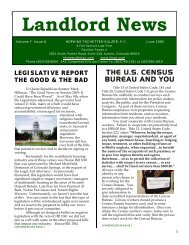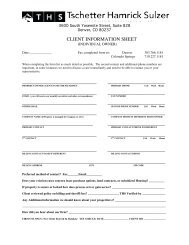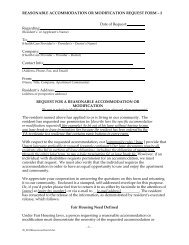WHEN A TENANT MOVES OUT - PART II - Tschetter Hamrick Sulzer
WHEN A TENANT MOVES OUT - PART II - Tschetter Hamrick Sulzer
WHEN A TENANT MOVES OUT - PART II - Tschetter Hamrick Sulzer
You also want an ePaper? Increase the reach of your titles
YUMPU automatically turns print PDFs into web optimized ePapers that Google loves.
evict the tenant when in fact the tenant had not abandoned. The second element is<br />
damages – what is the value of the tenant’s belongings and other consequential<br />
damages such as moving expenses. If the defendant (landlord) is able to defeat either<br />
one or both of the elements he will win the lawsuit. He will argue that he is not liable<br />
(first element) because the tenant moved out of the unit and that the tenant’s actions<br />
indicated that the he intended to relinquish control of the unit. The landlord will also<br />
argue that the tenant’s belongings had no value (second element), therefore, the tenant<br />
did not suffer any damages. Last month’s article discussed the legal standards of<br />
abandonment which go the first element. The following looks at damages.<br />
If the tenant is able to prove that the landlord is responsible for the wrongful<br />
eviction the court determines the measure of damages. Every tenant and many lawyers<br />
that the Firm has fought in a wrongful eviction believe that the measure of damages is<br />
the purchase price or the replacement cost of the goods. This couldn’t be further from<br />
the truth. Under Colorado law, the amount of damages a tenant can receive for<br />
personal property is not its replacement cost but rather its fair market value - what a<br />
willing disinterested party would pay for the property. Anyone that has been to the<br />
flea market knows that a person’s used personal property has little or no value to<br />
anyone other than its owner. This is why it is so important to take photos/video and<br />
make an inventory list because a court is not likely to award substantial damages to the<br />
tenant if you can prove the property at issue was used and of little value.<br />
Unfortunately, not all judges follow the law and use the fair market value<br />
standard. We have run into a few judges that will allow a tenant to testify as to the<br />
purchase price of the lost items (which should be irrelevant) as an indicator of the fair<br />
market value. For example, Ronnie Resident purchased the sofa ten years ago. The<br />
landlord threw the sofa away because it was 10 years old, looked like it had been<br />
through a war, and was left behind. Of course, Ronnie testifies that the couch was in<br />
great shape and he had paid $2,000 for it, so it must still be worth at least $1,000. In<br />
reality, the sofa is only worth $50 (if that) but because the judge considered the high<br />
purchase price, he awards Ronnie $500 in damages. There is no way around bad<br />
judges!<br />
©2013 <strong>Tschetter</strong> <strong>Hamrick</strong> <strong>Sulzer</strong> PC. All Rights Reserved.







